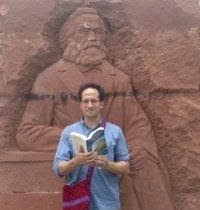I have returned to the farm where I lived before I went to Latin America. I had hoped to have the experience of living in a house without electricity but rural electrification has proceeded far enough in Guatemala that that was never possible. Here in Pennsylvania, however, near Amish country, I have been able to sleep in an 8 by 8 cabin alongside the woods. I do my nighttime reading by gas lamp and while I sleep the electrical synapses in my brain are unaffected by the magnetic fields unavoidably created when electrical currents flow through wires.
In an earlier letter I said using the giant hoe, azodon, so common to Central American peasants was the type of physical labor one couldn’t enjoy. After a few more experiences I was able to understand its utility—and the experience of being instructed in its use by men who had used it for decades, and passed along techniques filtered through generations. Holding an azodon now has different connotations for me. So I bought one. I have used it mostly to tend a few dozen corn plants I planted in the Central American style, with beans to coil up the stalks and squash around the base. I have also found
the azodon useful for tidying up at the edges of fields cultivated by our tractors.
The farm season is now in earnest—tomatoes—one of our major crops—are still a few weeks a way. But strawberries are over, beans have begun, and blueberries are about to begin. I am helping to supervise some college ageinterns. Because we live together we often talk about music. I asked one kid, born in the 1980s, what his favorite band is—he says Jethro Tull, especially Aqualung. This surprised me, but then again I have been
introducing them to songs from Jonathan Richman his group the Modern Lovers began recording the year I was born. They have been passing around a copy of Tom Robbins’ Even Cowgirls Get the Blues, discussing Edward Abbey, and various Hollywood movies. We work tying up tomatoes, pounding metal stakes into the ground, or riding around on tractors from the 1950s. I try to gently pass on a few insights: philosophical, and practical from my experience working on the farm, and the life I have lived after college. We pile into the van, then jump out the side door to round up lettuce, squash, or zucchini. As we chatter back and forth over walkie-talkies the choppers pass overhead from the landing strip over the hill. I think about other college age kids, with other machines, in much more dangerous environments. I wish them courage, wisdom, and luck. (“God has a special place in His heart for drunks, children, and the United States of America.”)
A mile away as the crow flies there is an exit from the four lane. Four-lane highways are modeled on the Autobahns designed in Germany under the National Socialists, and brought to our shores by Eisenhower who hoped that they would help us develop some of the efficiencies he witnessed in that system. Here as elsewhere, where it meets the regular roads the limited access highway has coughed up a huge gas station, franchise restaurants. They are all built according to blueprints, in accord with zoning specifications—and very reminiscent of those I have seen along four lane roads in El Salvador, Germany, Alaska, or Utah. From Alaska to Germany to Nicaragua, I have witnessed the same franchises sprouting up along the edges of roads like this, and the same weeds sprouting up in the disturbed and compact soil at the edges of their parking lots. But, if you drive a different direction—down winding country roads still untouched by what a civil engineer calls progress—you see hedgerows, stone farm houses, decaying white or red barns, mobile homes with lovingly tended gardens. There are towns you will miss if you blink. But if you don’t blink you see white two story houses with porches, simple churches, and a commercial district that may be a few country stores, a gas station with two pumps a “dairy mart” for ice cream or in the case of one—a single coke machine. This is the land before bulldozers—still shaped by local necessity and in with some remembrance of nature. The contours of the land are respected and the four-lane has not swept through to messianically abolish the landscape: “every valley shall be exalted and every mountain and hill made low, the crooked straight and the rough places plain.” These towns and these fields have drawn me to Central Pennsylvania for three years. Looking at them, I feel, as I did in Guatemala, that in the rural farming communities of America, there is a wonder that has not completely vanished from this earth.
Wednesday 22 June 2005
Subscribe to:
Posts (Atom)
